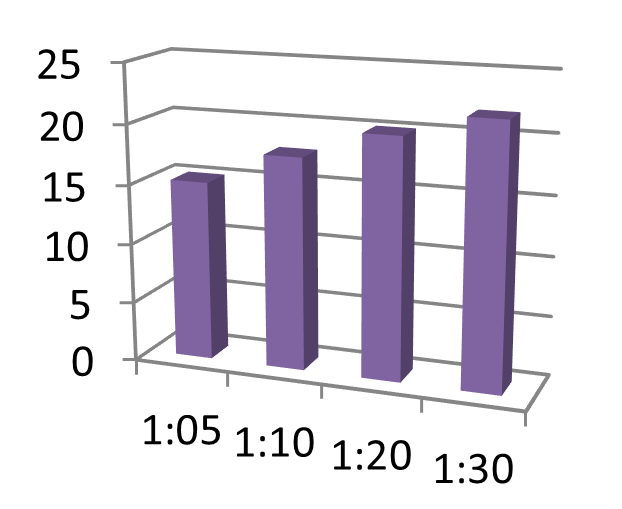TECHNOLOGY OF OBTAINING DRY EXTRACTS FROM HERBAL MIXTURES
UDC 615.262.1
Abstract
In modern medical practice, a special place is occupied by herbal mixtures, the range of which is constantly increasing, and the list of indications for use is expanding. However, there are a number of inconveniences for patients when using them: the presence of an additional technological stage for obtaining an aqueous extract; lack of accuracy when dosing this form and a short shelf life at home. All this makes the search for new, more rational dosage forms based on fees relevant. Such dosage forms include dry extracts, which are obtained on an industrial scale. This type of total preparations can be used as an intermediate in the preparation of finished dosage forms (tablets, capsules, etc.), which are easy to use, well dosed and have a long shelf life. Purpose: development of technology for obtaining dry extracts from herbal mixtures - urological, nephrolytic and hypoglycemic. Materials and methods. Based on the use of medicinal plants in folk and scientific medicine, various compositions of herbal mixtures have been developed. On the basis of pharmacological screening, the most effective formulations were selected, which were chosen as objects of study: "Urological collection"; "Nephrolytic collection"; "Hypoglycemic collection". When obtaining dry extracts, the methods of maceration and repercolation were used. The quality of the obtained extracts was assessed according to the following indicators: appearance, authenticity, moisture content, heavy metals, microbiological purity, quantitative content of biologically active substances (polyphenolic compounds and polysaccharides). The technological parameters of the studied phytocompositions have been established. The optimal extraction conditions were determined: raw material fineness – 2–3 mm, extractants: 50% ethyl alcohol (“Urological”) and purified water (“Hypoglycemic” and “Nephrolytic”), the optimal ratio of raw materials and extractant is 1 : 30, temperature – 70–80 °С ("Urological" and "Nephrolytic") and 90–100 °С ("Hypoglycemic"). The optimal method for obtaining dry extracts from herbal mixtures, maceration, was experimentally selected. A technology for obtaining dry extracts from herbal mixtures has been developed, in particular, the influence of extraction conditions depending on temperature, the degree of grinding of raw materials, the type of extractant, the ratio of raw materials and extractant has been studied.
Downloads
Metrics
References
Samylina I.A., Sorokina A.A., Pyatigorskaya N.V. Farmateka, 2010, no. 10, pp. 80–82. (in Russ.).
Dzhamshedov Dzh.N., Rakhimov I.F., Khaydarov K., Izzatulloyev A.S., Musozoda S.M., Shpichak O.S. Nauka i in-novatsiya, 2018, no. 2, pp. 105–108. (in Russ.).
Khishova O.M. Vestnik farmatsii, 2004, no. 2 (24), pp. 21–25. (in Russ.).
Gosudarstvennaya farmakopeya Respubliki Uzbekistan. [State Pharmacopoeia of the Republic of Uzbekistan]. Tashkent, 2021, vol. 1-2. (in Russ.).
VFS 42 Uz-0266-20. Tsvetki tysyachelistnika tavolgolistnogo. [VFS 42 Uz-0266-20. Flowers of yarrow]. (in Russ.).
VFS 42 Uz-0334-2007. Trava zizifory tsvetonozhechnoy. [VFS 42 Uz-0334-2007. Jujube herb]. (in Russ.).
GOST 976251. List shelkovitsy beloy. [GOST 976251. White mulberry leaf]. (in Russ.).
Gosudarstvennaya farmakopeya Rossiyskoy Federatsii XIV izdaniya. [State Pharmacopoeia of the Russian Federation XIV edition]. Moscow, 2018, vol. 3, 1294 p. (in Russ.).
Shulepova I.I. Farmakognoziya: uchebnoye posobiye. [Pharmacognosy: textbook.]. Ussuriysk, 2016, pp. 38–40. (in Russ.).
Savchenko L.N., Marinina T.F., Karpenko V.A., Saushkina A.S. Razrabotka tekhnologii i analiza ekstrakta zhidkogo iz list'yev i tsvetkov kashtana konskogo obyknovennogo v kachestve protivovospalitel'nogo i venotoniruyushchego sredstva. [Development of technology and analysis of a liquid extract from the leaves and flowers of horse chestnut as an anti-inflammatory and venotonic agent]. 2015, pp. 612–617. (in Russ.).
Fedoseyeva L.M., Chistova Yu.I. Byulleten' meditsinskoy nauki, 2018, no. 2, pp. 37–41. (in Russ.).
Gosudarstvennaya farmakopeya Rossiyskoy Federatsii XIV izdaniya. [State Pharmacopoeia of the Russian Federation XIV edition]. Moscow, 2018, vol. 2, 1980 p. (in Russ.).
Chuyeshov, V.I., Gladukh, Ye.V. Tekhnologiya lekarstv promyshlennogo proizvodstva. [Industrial drug technology]. 2014, pp. 403–445. (in Russ.).
Alekseyev K.V., Kedik S.A., Blynskaya Ye.V., Alekseyev V.K., Maslennikova N.V. Farmatsevticheskaya tekhnologi-ya. [Pharmaceutical technology]. Moscow, 2015, 672 p. (in Russ.).
Zhumakanova B.S., Orazaliyeva M., Kesikova A.A., Ibadullayeva G.S., Sakipova Z.B. Vestnik KazNMU, 2018, no. 4, pp. 163–166. (in Russ.).
Suina I.O., Terninko I.I. Razrabotka i registratsiya lekarstvennykh sredstv, 2017, no. 4 (21), pp. 202–205. (in Russ.).
Zhumashova G.T., Sayakova G.M., Gemedzhiyeva N.G., Bekezhanova T.S. Vestnik KazNMU, 2016, no. 1, pp. 531–534. (in Russ.).
Farmanova N.T., Aliyev Kh.U., Urmanova F.F. Tezisy dokladov XIII nauchnogo Rossiyskogo natsional'nogo kongressa «Chelovek i lekarstvo». [Abstracts of the XIII Scientific Russian National Congress “Man and Medicine”]. Moscow, 2006, p. 599. (in Russ.).
Farmanova N.T., Aliyev Kh.U., Urmanova F.F. Farmatsevticheskiy zhurnal, 2009, no. 2, pp. 68–70. (in Russ.).
Farmanova N.T., Farmanova Sh.I., Kadirov Z.I. Austrian Journal of Technical and Natural Sciences, 2017, vol. 3-4, pp. 37–41.
Malikova G.Yu., Juraeva A.A., Farmanova N.T., Maksudova A.N. Azizov Sh.I. O'zbekiston farmatsevtik xabarno-masi, 2014, no. 3, pp. 48–52. (in Uzb.).

Copyright (c) 2023 chemistry of plant raw material

This work is licensed under a Creative Commons Attribution 4.0 International License.

This work is licensed under a Creative Commons Attribution 4.0 International License.
The authors, which are published in this journal, agree to the following conditions:
1. Authors retain the copyright to the work and transfer to the journal the right of the first publication along with the work, at the same time licensing it under the terms of the Creative Commons Attribution License, which allows others to distribute this work with the obligatory indication of the authorship of this work and a link to the original publication in this journal .
2. The authors retain the right to enter into separate, additional contractual agreements for the non-exclusive distribution of the version of the work published by this journal (for example, to place it in the university depository or to publish it in a book), with reference to the original publication in this journal.
3. Authors are allowed to post their work on the Internet (for example, in a university repository or on their personal website) before and during the review process of this journal, as this may lead to a productive discussion, as well as more links to this published work.











